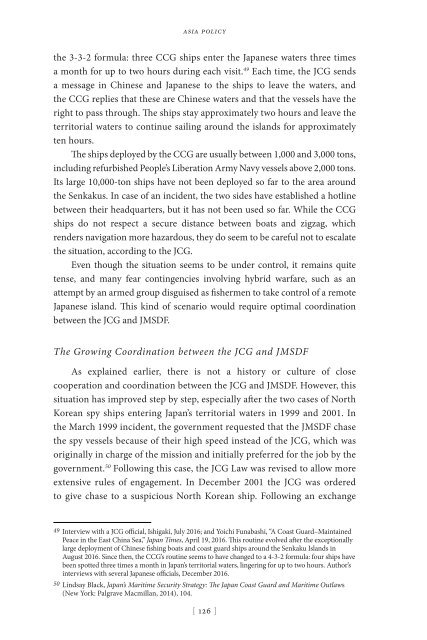2jBVKVf
2jBVKVf
2jBVKVf
You also want an ePaper? Increase the reach of your titles
YUMPU automatically turns print PDFs into web optimized ePapers that Google loves.
asia policy<br />
the 3-3-2 formula: three CCG ships enter the Japanese waters three times<br />
a month for up to two hours during each visit. 49 Each time, the JCG sends<br />
a message in Chinese and Japanese to the ships to leave the waters, and<br />
the CCG replies that these are Chinese waters and that the vessels have the<br />
right to pass through. The ships stay approximately two hours and leave the<br />
territorial waters to continue sailing around the islands for approximately<br />
ten hours.<br />
The ships deployed by the CCG are usually between 1,000 and 3,000 tons,<br />
including refurbished People’s Liberation Army Navy vessels above 2,000 tons.<br />
Its large 10,000-ton ships have not been deployed so far to the area around<br />
the Senkakus. In case of an incident, the two sides have established a hotline<br />
between their headquarters, but it has not been used so far. While the CCG<br />
ships do not respect a secure distance between boats and zigzag, which<br />
renders navigation more hazardous, they do seem to be careful not to escalate<br />
the situation, according to the JCG.<br />
Even though the situation seems to be under control, it remains quite<br />
tense, and many fear contingencies involving hybrid warfare, such as an<br />
attempt by an armed group disguised as fishermen to take control of a remote<br />
Japanese island. This kind of scenario would require optimal coordination<br />
between the JCG and JMSDF.<br />
The Growing Coordination between the JCG and JMSDF<br />
As explained earlier, there is not a history or culture of close<br />
cooperation and coordination between the JCG and JMSDF. However, this<br />
situation has improved step by step, especially after the two cases of North<br />
Korean spy ships entering Japan’s territorial waters in 1999 and 2001. In<br />
the March 1999 incident, the government requested that the JMSDF chase<br />
the spy vessels because of their high speed instead of the JCG, which was<br />
originally in charge of the mission and initially preferred for the job by the<br />
government. 50 Following this case, the JCG Law was revised to allow more<br />
extensive rules of engagement. In December 2001 the JCG was ordered<br />
to give chase to a suspicious North Korean ship. Following an exchange<br />
49 Interview with a JCG official, Ishigaki, July 2016; and Yoichi Funabashi, “A Coast Guard–Maintained<br />
Peace in the East China Sea,” Japan Times, April 19, 2016. This routine evolved after the exceptionally<br />
large deployment of Chinese fishing boats and coast guard ships around the Senkaku Islands in<br />
August 2016. Since then, the CCG’s routine seems to have changed to a 4-3-2 formula: four ships have<br />
been spotted three times a month in Japan’s territorial waters, lingering for up to two hours. Author’s<br />
interviews with several Japanese officials, December 2016.<br />
50 Lindsay Black, Japan’s Maritime Security Strategy: The Japan Coast Guard and Maritime Outlaws<br />
(New York: Palgrave Macmillan, 2014), 104.<br />
[ 126 ]


